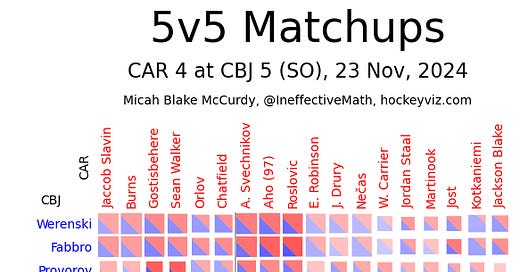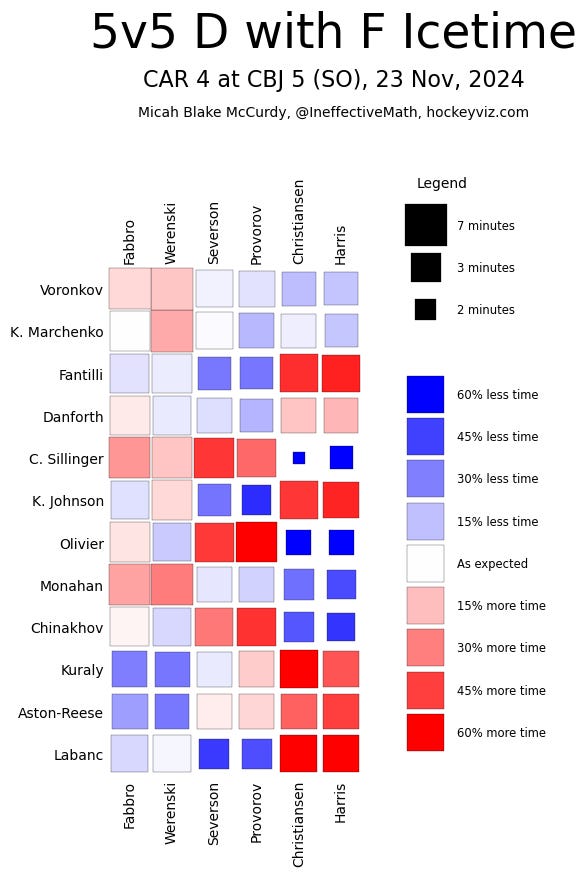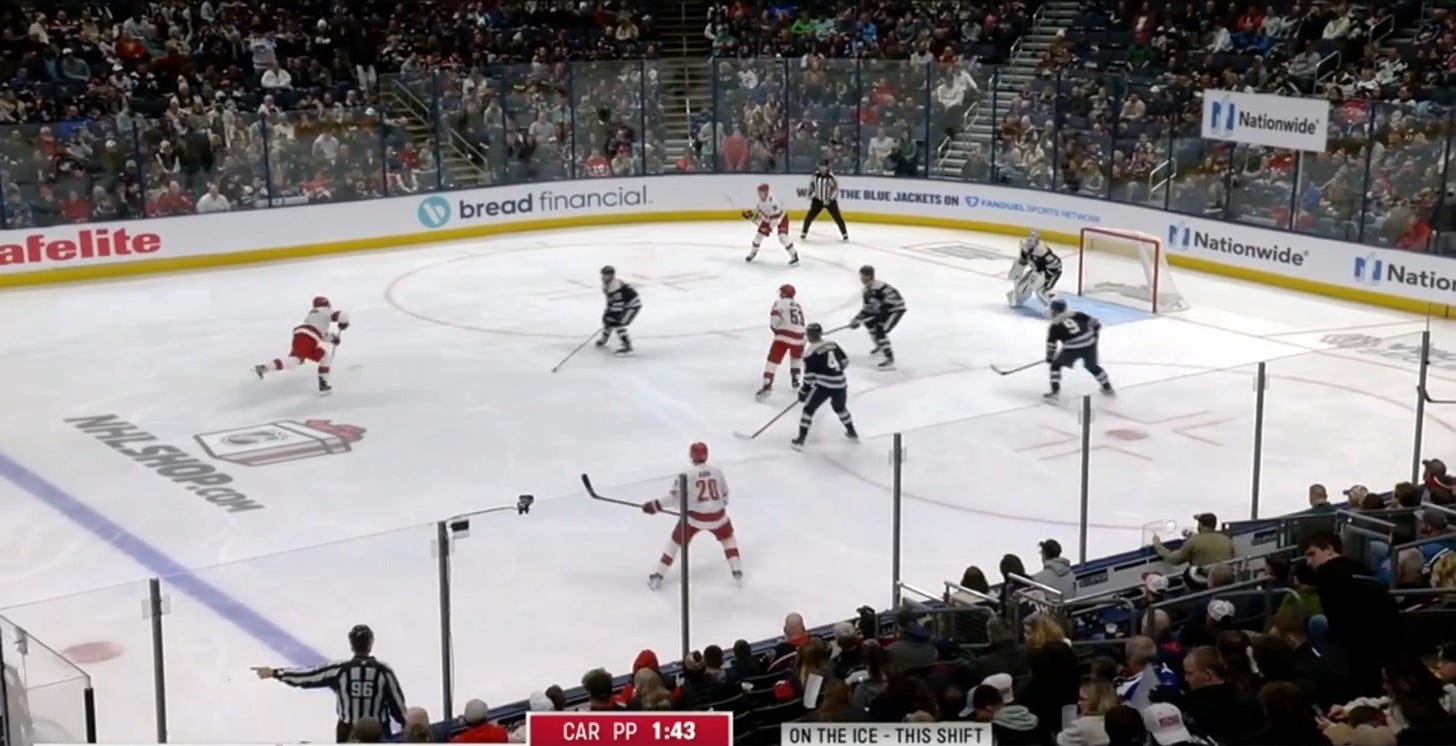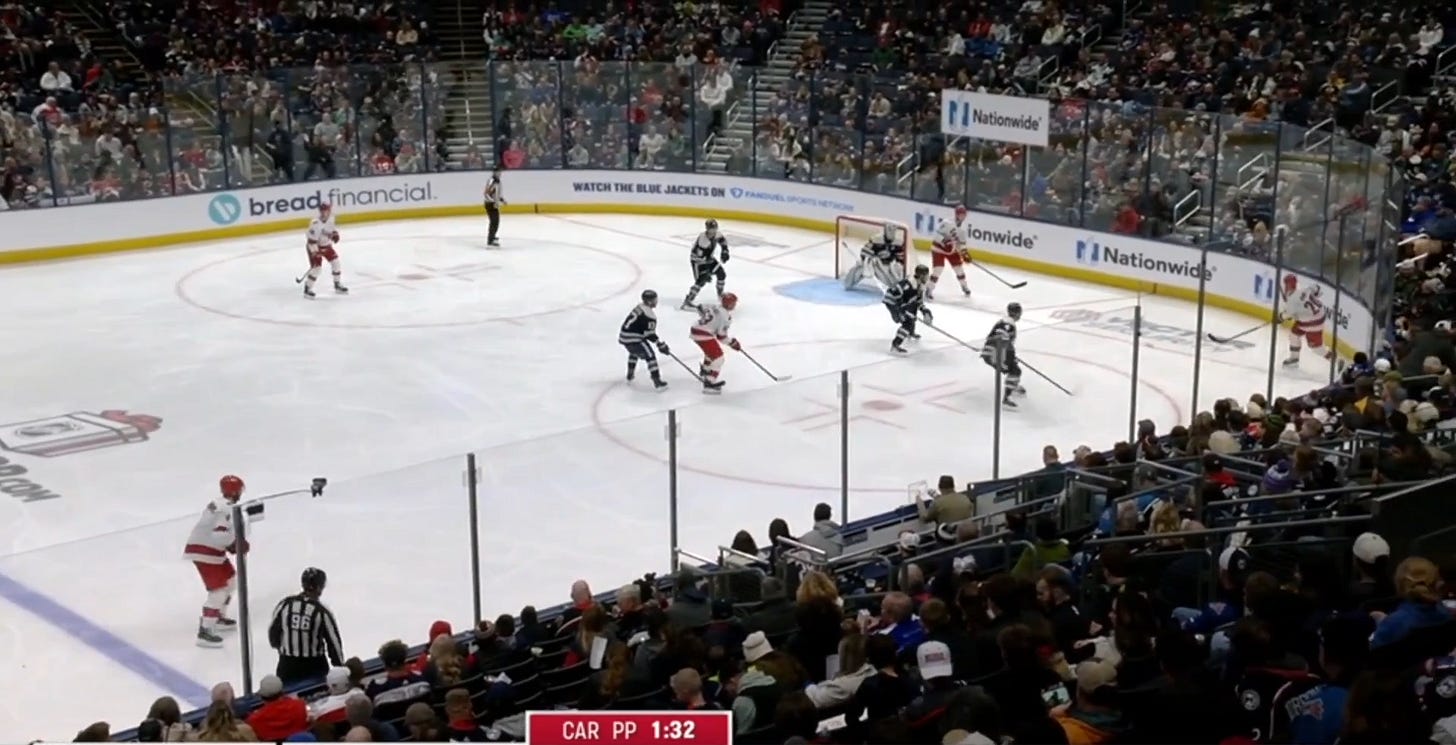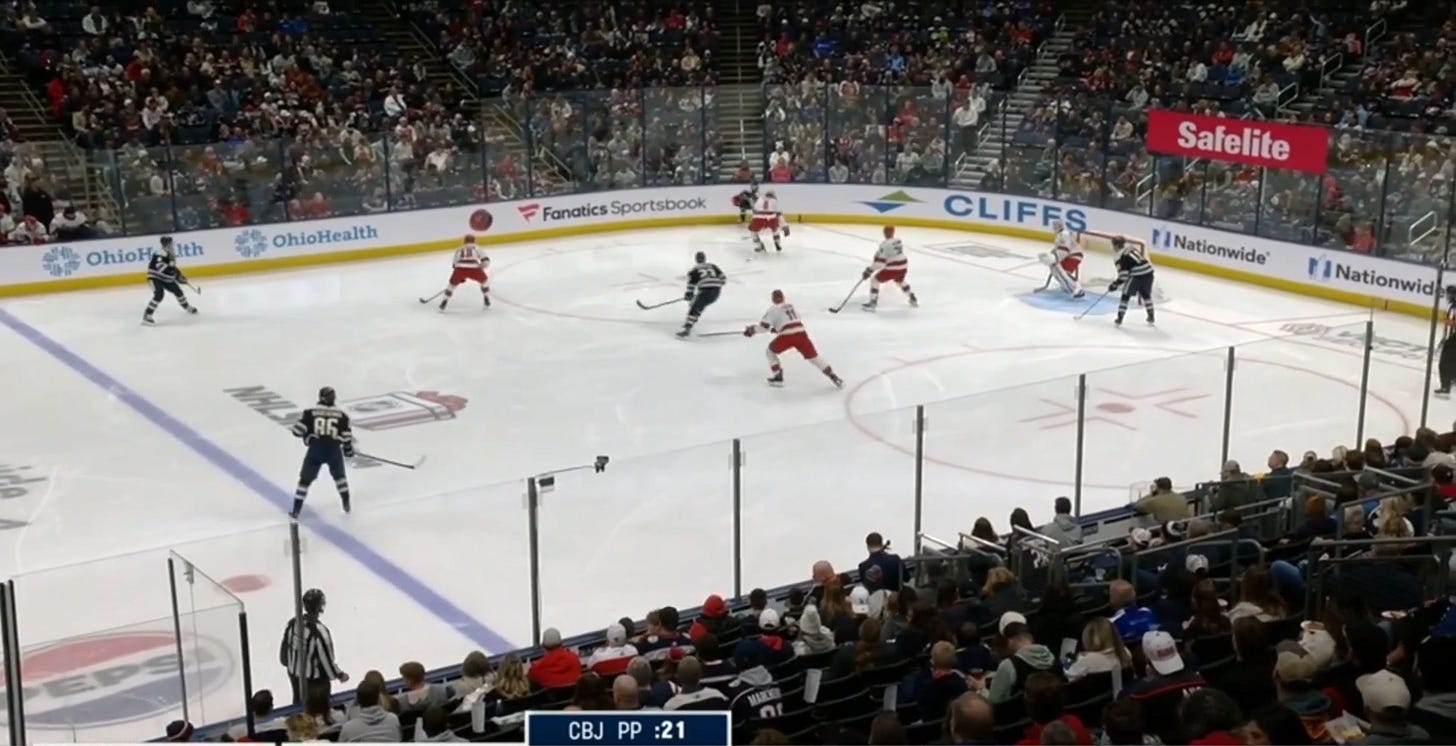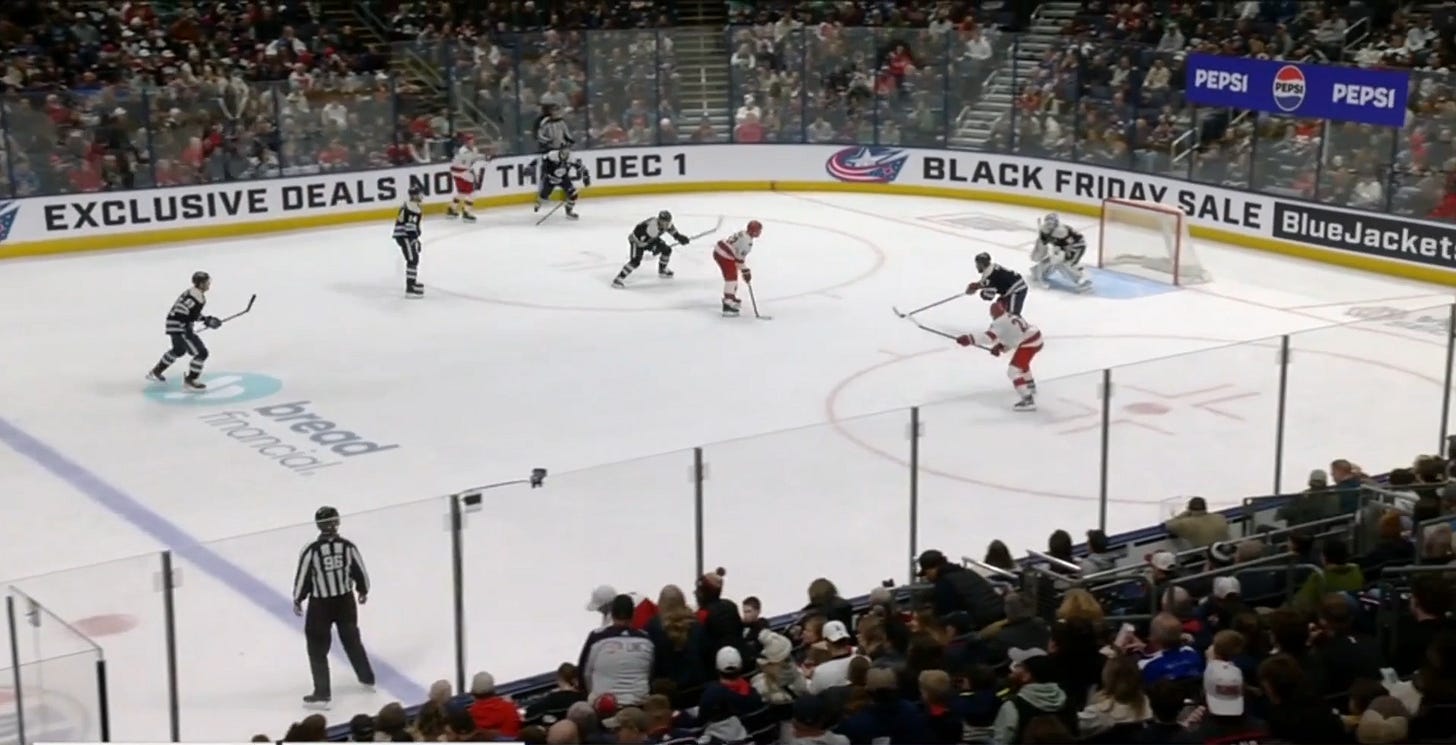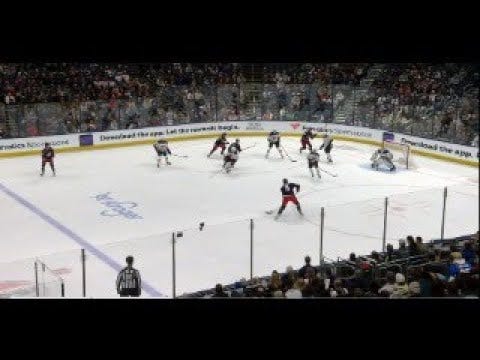CBJ vs CAR 11/23
On coaching, powerplay tactics, coverage breakdowns from forwards, Chinakhov, Werenski’s new move and potential weakness for Carolina's Third Pair/strength for CBJ first line
A big win from a growing team that made a statement by not breaking under the pressure of the Carolina Hurricanes.
The Stats
The Carolina Hurricanes are the Carolina Hurricanes. In a retooling year, after making the correct decision to not hang onto declining players for big money, they are finding themselves on top of the Metro. Rod Brind’Amour has a team that plays an incredibly intense pressure style that forces good hockey from their opponents or otherwise a complete massacre.
Going into this game, I felt like it would have been a complete massacre. On the shot chart, Carolina certainly had an advantage. The Blue Jackets won very few matchups mostly thanks to the decidedly not-locked-in performance of Jesperi Kotkaniemi.
What was nice to see from the Blue Jackets was a step-up performance and lock-in from top players. Kent Johnson continued to play well, Kirill Marchenko is growing in his competitiveness and Damon Severson, Ivan Provorov and Dante Fabbro showed that they can respond to challenges. It’s nice to see players get up for the game instead of wilting under pressure.
At the end of the day, the game was very close. Plenty of special teams and non 5v5 to go around but the numbers are similar enough.
Largely, Carolina resorted to point and distance shooting for the majority of their shot advantage. That’s not to say there wasn’t danger but the Blue Jackets got chances of their own.
Not only were the 5v5 shots from Carolina from distance but they also were missed and/or blocked to a higher degree. The Blue Jackets made the game closer by getting more pucks to the net but also by bringing a strong defensive commitment.
The most notable performers for the Blue Jackets were the young matchup line players of Cole Sillinger and Yegor Chinakhov though Zach Werenski’s low performance merits consideration. Voronkov-Monahan-Marchenko were also very good this game it just didn’t result in big contribution volume at 5v5.
For Carolina, Svechnikov, Aho and Carrier standout. Aho is a brilliant player who could have easily had a hat trick, Svechnikov is assertive and certainly contributes on volume. William Carrier is a perfect fit next to Jordan Staal on a metric breaking matchup line.
Stories of the Game
Coaching
Rod Brind’Amour is a fantastic coach demonstrated most by how detailed and assertive every player on the team is. Their pressure and defensive sticks are overwhelming and they make a lot of smart offensive choices with the puck. Slavin and Burns are a terrifying defense pair that is aging well and Aho is just a brilliant player all around.
His team applies so much pressure that the only way to beat it is to simply play good hockey. If you hold onto the puck and fail to make plays, they’ve got you. If you chip the puck out, they’re coming back in waves.
Dean Evason had some interesting tactics, or really line deployment decisions, that helped stymie the tide.
First, he sat James van Riemsdyk and Jack Johnson, two aging and slow players (and also played Werenski 1 million minutes).
Second, he distributed those minutes across the roster very evenly. This is a departure from his normal choices to load up specific deployment with his top pair. That helped Werenski-Fabbro float the rest of the roster while Chinakhov-Sillinger-Olivier and a committed Provorov-Severson took the toughest assignment.
Perhaps that also explains the relative success of Svechnikov-Aho but there’s plenty of chances against Werenski baked in there too.
I thought Jordan Harris played a notable game especially in his ability to make smart quick choices to keep possession. His skating helped break up the Carolina attack and “good hockey” plays helped the Blue Jackets reassert possession without succumbing to the endless waves after poorly cleared pucks.
Rod Brind’Amour’s line change 3v3 OT strategy seems incredible. An easy way to disorient the opposition lines and mitigate risk from faceoff win or loss. Brent Burns can go both ways, Staal and Slavin can shut down anyone in a half court game but Necas and Aho are terrifying attackers. A cool bit of tactics to create situation advantages.
Powerplay Tactics
Both Carolina and Columbus are showing an evolution, or a response to some of last years’ evolutions, in powerplay formation and motion. Both utilize the common 1-3-1 but seem to be aware that the cross-lane onetimer is a takeaway priority of penalty killing formations. It’s also only really successful if you have transcendent talents like Alex Ovechkin, Steven Stamkos, Patrik Laine, Tage Thompson or prime Mika Zibanejad.
Here, you can see Carolina utilize a sort of 2-1-2 that seems to be a trend in the league or, at the very least, in Montreal and sometimes Columbus.
Aho comes up high and there are two point players with him and Gostisbehere. Jackson Blake is in the permanent bumper.
Aho gets the puck and moves down to the goal line where Caroline flexes the formation to create net-front to bumper or weakside looks.
Later, though, Carolina changes the formation and leaves the middle open.
Carolina moves initially into two sorts of pairs. The “flanks” or “half-wall” players are accompanied by a net-front and an additional player on the goal-line rather than one stationed in a permanent bumper.
This results in shorter cross-seam passes like the threat of Jackson Blake to Sebastian Aho and then the follow up actual goal scored here. Sebastian Aho is a very good shooter but he’s not beat perfectly set goaltenders clean and they can’t do anything about it good.
The Blue Jackets love newlyacquired Sean Monahan’s skillset in the bumper. He’s really good at making strong players through pressure with excellent poise and patience. They also love flexing their formation and offering different attack options.
Monahan comes into high ice to support Marchenko’s point possession.
When the puck goes to Voronkov at the goal line (and then back up for the picture) Monahan moves to the netfront.
When Kent Johnson gets the puck he flexes back into the bumper for middle ice shot. Johnson doesn’t get the pass cleanly and Carolina defends it well because it’s slow.
Earlier in the game, Monahan comes into the high ice and attacks downhill which Kent Johnson uses to his the cross-seam pass. Marchenko dusts off the puck and it isn’t overly dangerous.
Also earlier in the game, Kent Johnson uses some of this movement to create a net-front goal for Dmitri Voronkov. Werenski keeps the puck, Monahan comes high, Voronkov flexes out to the goal line. Kent Johnson recovers the puck, moves it to Werenski and Monahan drags his defender up with him. Werenski moves the puck behind the defense and hits Voronkov for the goal.
Carolina seems to be moving a little more cutting edge but with Kent Johnson returning it’s nice to see some life from a Blue Jackets powerplay that was far too stagnant for even the star power of Werenski-Gaudreau-Laine to succeed. Do not overlook Monahan’s role in all of this either.
CBJ Forward Defensive Miscues for Goals Against
The Blue Jackets are still working on building defensive and responsible habits into their forward lines. They are filled with young players and otherwise fourth liners. It’s going to be a learning process.
On this sequence, it’s all Adam Fantilli. It starts with an incredible handling move from Kent Johnson and Fantilli, unfortunately, disrupting Johnson’s crosslane pass with a minor puck touch. It’s not the end of the world but it’s a mistake that doesn’t need to happen.
Play continues for a while before it turns really bad for Fantilli. Labanc mishandles the puck and Fantili simply runs into him. Lots can happen fast but that’s certainly avoidbale. So far just weird plays where you’d like more presence and awareness.
Once in the D zone, Fantilli switches off and it causes a goal.
Fantilli works to occupy Jalen Chatfield and prevent a quick strike. After that, though, he watches the puck and curls away when Chatfield stops at the backdoor. Severson and Provorov are both facing the other direction and it appears Fantilli offers no communication that he was abandoning his responsibility.
Perhaps that’s the right read as the Blue Jackets flow into zone and Fantilli wants to move up to defend but awareness of your teammates’ field of vision is important and, worse comes to worse, talk.
Carolina moves the puck and now Damon Severson is caught. Allow the Carolina player to walk in and take Chatfield’s stick or try to front the shot and get a block. Carolina goal.
There are two mistakes on this one.
Mathieu Olivier makes a weak play on only the stick and leaves the Blue Jackets somewhat vulnerable if possession changes. If he’s below the puck and plays the body, the Blue Jackets are more insured against poor outcomes. Right now, Chinakhov has pushed back two Carolina players so the upside of Olivier’s maneuver is an even rush situations with one of the fastest players in the league. A wager and one that turned out poorly.
The bigger mistake in my estimation was in Sillinger’s defensive coverage choice after. Instead of eliminating an option and sticking with the high forward in matchup coverage and allowing his defensemen to handle their 1on1 matchups, he curls and forgets about the player behind him. His stick isn’t aware of the location of the threats and it’s overextended allowing Carolina to slip a pass through this triangle.
Now, Carolina has a 2 on 1 in the inner slot and Provorov is completely sold out. Carolina now has a lead that they would protect until the dying moments.
All to say, these are necessary growing pains of a young roster. Fantilli hasn’t been a good defensive player yet in his career but he’s got plenty of time and it’s far too soon to worry. Cole Sillinger is, to me, miscast as a good two-way shutdown center. The Blue Jackets, quite frankly, don’t really have any better options.
The Blue Jackets have plenty of time to let these two continue to develop and gain skills on the job at the NHL level. These important minutes, though they don’t result in short term wins, can be considered investments in the future of the club as long as they learn from their mistakes.
Yegor Chinakhov
Yegor Chinakhov’s skating speed and quickness to pucks breathed life into the Blue Jackets matchup line. He wasn’t the only force, Sillinger and Olivier each played their roles as well, but he nearly single-handedly tilted the ice with intense vertical threat.
Not the best outcome but his capacity to threaten bought the Blue Jackets some time away from their own end of the rink.
Chinakhov comes back to reload so that he can build speed. He oftentimes performs these middle-speed dominant maneuvers in the way that a center would. Voronkov shows some of his brilliant space chip passing and Chinakhov creates multiple dangerous looks with his legs.
Certainly lucky to create danger with this one but he’s at the very least threatening behind Carolina’s defense.
Zach Werenski’s New Move
You might see Werenski’s sub-par statline and think he had a poor game. He did not. Though he wasn’t overly present on shot contributions his game was critical for the Blue Jackets.
Now, my contributions are less than the NHL’s and I think there’s probably room to talk about this sequence. You might notice that HockeyViz has a very large xG chance for Zach Werenski but my tracking indicates none.
The sequence is a great one to illustrate Werenski’s ability. It isn’t necessarily his “new move” but does illustrate part of his activation for possessional security. More on that in a bit.
This was Werenski’s only puck touch in the offensive zone on this sequence. He tapped the puck with his stick and then had it lifted and drew a penalty. According to NHL PxP data this was a snap shot from just outside the blue paint. From NaturalStatTrick’s perspective that’s a high danger chance. From HockeyViz’s thats a snap shot worth .14 xG.
It’s certainly a high quality chance and one that was extremely threatening. It’s still hard to confidently say it was a shot at all and one that further makes it difficult to understand and evaluate my own tracking project. A problem, I imagine, I’ll continue to have.
Now, let’s get into Werenski’s new move. If you followed my writing last year, I broke down Werenski’s skills into great detail.
One of the hallmarks of his game was always been activating into the play. This year, he’s using it to devastating effect. In the above clip, I started it really early to demonstrate how he’s extremely involved in getting plays started.
Here, he uses his anticipation and jump to create clarity for his teammates. He makes the pass and decision easy because he has an advantage. Especially in the neutral zone this creates speed differentials because he’s coming as a sort of second wave through ambiguous battles.
Where he was often been a “rover” or rule-breaker, as any team’s best players should be, his desired way to play is now fully and functionally supported by Dean Evason in a way that makes it easy for him to consistently leverage his favorite weapon.
It helps, too, that he’s packing new skating juice. Must be that carnivore diet.
What his “new move” is however is in applying his skating and puck carrying to create success. Last year, he anticipated loose pucks well and then jumped to create offense.
This year, he’s anticipating them well then shielding the opposition with his body and riding their attack into his forward momentum. He’s carrying the puck with one hand, absorbing their impact and making plays. I don’t know if it’s lucky that he hasn’t been further disrupted or whether this puck protection is a genuine new skill.
This clip illustrates this move best.
He establishes early contact and gets stick on puck.
Uses his body to steal momentum and use one hand on his stick in a pseudo underhandle and then strides through the neutral zone and links it for a pass.
NSFW for Kochetkov’s injury if you’re squeamish.
Werenski shields Sean Walker in overtime while corralling the puck displaying this puck protection through activation as well.
Werenski has always had a large frame but wasn’t ever a prolific user of that advantage. He’s been 6’2” and 215 for a long time but always more an intelligent finesse player. If this is how he uses that advantage in conjunction with his other skills, he could only be beginning to reach his ceiling.
Carolina’s Third Pair Weakness vs CBJ Top Line Strength
A key roster renovation for Carolina was dumping their aging and expensive second pair, elevating Orlov and Chatfield into that role and leveraging their forward defensive skill to create a possession monster third pair of Shayne Gostisbehere and Sean Walker.
Late in the game, the wall and below-dots dominant line of Voronkov-Monahan-Marchenko showed how it might be exploited.
Voronkov and Marchenko are special players. Not many defensemen can fight of Voronkov in the corners but you could see his confidence in puck protection and in throwing his physical weight to create an advantage against Shayne Gostisbehere.
Perhaps, I’m now realizing, this is simply a strength of the line. Marchenko, Voronkov and Monahan are big bodies who are intense on sticks and all have the hockey sense and creativity to be formidable beneath the hashes. They did it here against Slavin-Burns who are no slouches.
I long though Monahan to be probably a 2nd line center. He produced well (in terms of 5v5 points/60) with Nikolaj Ehlers and Tyler Toffoli who form a nearly perfect complementary line. With Marchenko and Voronkov, and Chinakhov before, you can see how intelligent and effective he is at supporting and creating from wall battles. Perhaps he’s simply better at that style than with high flying transition wingers.
The Benefits of Dot Lane Support
Tactics are pre-planned movements and on-ice locations designed to put players on the same page. These, especially noticeable in the Blue Jackets’ breakout wall structure, create clarity for players who are in difficult situations. Too much happens too fast for every player to be constantly aware of the position of every other player while also knowing where they’re going next. Under intense pressure, you simply cannot make perfect decisions. So the best teams use shortcuts so that some of the thinking is already done for you. You can focus on doing your job, such as winning a puck battle, and everyone will know what happens next.
On the game-tying goal with an empty net, the Blue Jackets used the ice-geography to turn tactics into clarity into speed into a goal.
Kent Johnson moves down the wall and under intense pressure throws a no-look backhand to his dot-support in Sean Monahan. He knows he’ll be there and can deceive the defense with his handling tricks and body language.
Because Sean Monahan knows a pass can come he can prepare his body to protection his puck reception.
Because he prepared his puck reception and knows Kirill Marchenko will be waiting on the opposite dot, he can spin off defensive pressure to throw a pass to waiting teammate.
Goal, tie game and win in the shootout.

